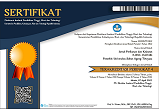Byssogenesis of Green Mussel Perna viridis as a Biomarker of Microplastic Pollution
Abstract
The presence of microplastic in the enviroment is a problem because they are persistent and they are consumed by organisms. Microplastic will affect aquatic life as a result various types of contamination in the aquatic enviroment can enter the body of green mussel. The ability to develop mussel is determined by the strength of the byssus. Utilization of green mussel byssus as biomarker to detect microplastic pollution is still a rare thing to do. The purpose of this study is to know the microplastic effect on the production off green mussel byssus. Green mussel with lengths of 4.1 - 5.0 cm were collected from Maccini Baji Water, Labakkang District, Pangkep Regency. The experimental desigh used is a Completely Randomized Design exposure was carried out for 7 days with microplastics concentration namely 0, 0.05, 0.5 and 5 g/L using polyethylene microplastics usually used as a raw material for scrub bath. The results of study show that production of green mussel byssus exposed at all concentration on day 1-6 were not significantly different at all concentration, but 7 days there significantly different 0 g/L treatment 0 g/L from 5 g/L. This mean that the green mussel byssus can be used as a microplastic pollution biomarker with a testing duration of 7 days
Keywords
Full Text:
PDFReferences
Andrady AI. 2011. Microplastics in the marine environment. Marine Pollution Bulletin 62: 1596 – 1605.
Gesamp. 2015. Sources, Fate and Effects of Microplastics in the Marine Environment: A Global Assessment. London: International Maritime Organization.
Lachance AA, Myrand B, Trremblay R, Koutitonsky V, Carrington E. 2008. Biotic and Abiotic Factors Influencing Attachment Strength of Blue Mussels Mytilus edulis in Suspended Culture. Aquatic Biology 2(9):119 – 129.
Lee KW, Shim WJ, Kwon OY, Kang JH. 2013. Size-Dependent Effects of Micro Polystyrene Particles in the Marine Copepod Tigriopus japonicus. Environmental Science & Technology 47: 11278 – 11283.
Li Q, Sun C, Wang Y, Cai H, Li L, Li J, Shi H. 2019. Fusion of Microplastics into the Mussel Byssus. Environmental Pollution 252: 420 – 426.
Paul-Pont I, Lacroix C, Fernandez CG, Hegaret H, Lambert C, Le Goic N, Frere L, Cassone AL, Sussarellu R, Fabioux C, Guyomarch J. 2016. Exposure of Marine Mussels Mytilus spp. to Polystyrene Microplastics: Toxicity and Influence of Fluoranthene Bioaccumulation. Environmental Pollution 216: 724 – 737.
Pittura L, Avio CG, Giuliani M E, d’Errico G, Keiter S.H, Cormier B, Gorbi S, Regoli F. 2018. Microplastics as Vehicles of Environmental Pahs to Marine organisms: Combined Chemical and Physical Hazards to the Mediterranean Mussels, Mytilus galloprovincialis. Frontiers in Marine Science 5: 1 – 15.
Rist SE, Assidqi K, Zamani NP, Appel D, Perschke M, Huhn M, Lenz, M. 2016. Suspended micro-sized PVC particles impair the performance and decrease survival in the Asian green mussel Perna viridis. Marine Pollution Bulletin 111(1): 213 – 220.
Sahwan FL, Martono DH, Wahyono S, Wisoyodharmo, LA. 2005. Sistem Pengolahan Limbah Plastik di Indonesia, Jurnal Teknik Lingkungan BPPT 6(1) 311 – 318.
Santana MFM, Ascer LG, Custodio MR, Moreira FT & Turra A. 2016. Microplastic Contamination in Natural Mussel Beds From a Brazilian Urbanized Coastal Region: Rapid Evaluation Through Bioassessment. Marine Pollution Bulletin 06: 183 – 189.
Santana MFM, Moreira FT, Turra MA. 2017. Trophic transference of microplastics under a low exposure scenario: Insights on the likelihood of particle cascading along marine food-webs. Marine Pollution Bulletin 121: 154 – 159.
Schrank I, Trotter B, Dummert J, Scholz-Böttcher BM, Löder MGJ, Laforsch C. 2019. Effects of Microplastic Particles and Leaching Additive on the Life History and Morphology of Daphnia magna. Environmental Pollution 255: p133233.
Suseno H dan Panggabean SM. 2007. Merkuri : Spesiasi dan Bioakumulasi pada Biota Laut. Jurnal Tenologi Pengelolaan Limbah Pusat Teknologi Limbah Radioatif 10(1): 66 – 78.
Van Cauwenberghe L, Janssen CG. 2014. Microplastics in Bivalves Cultured for Human Consumption. Environmental Pollution 193: 65 – 70.
Wright SL dan Kelly FJ. 2017. Plastic and Human Health: A Micro Issue?. Environmental Science Technology 51(12): 6634 – 6647.
Yaqin K, Tresnati J, Rape RA, Aslam M. 2014. The Use of Byssogenesis of Green Mussel, Perna Viridis, as a Biomarker in Laboratory Study the use of Byssogenesis of Green Mussel, Perna viridis, as a Biomarker in Laboratory Study. Current Nutrition & Food Science 10(7): 100 – 106.
Yaqin K, Lay BW, Riani E, Masud ZA, Hansen PD. 2011. Hot Spot Biomonitoring of Marine Pollution Effects Using Cholinergic and Immunity Biomarkers of Tropical Green Hot Spot Biomonitoring of Marine Pollution Effects using Cholinergic and Immunity Biomarkers of Tropical Green Mussel (Perna viridis) of the Indonesian Water. Toxicology and Environmental Health Sciences 3(14): 356 – 366
DOI: http://dx.doi.org/10.33512/jpk.v10i1.7428
Refbacks
- There are currently no refbacks.



_-_Copy1.png)